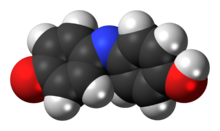Indophenol is an organic compound with the formula OC6H4NC6H4OH. It is deep blue dye that is the product of the Berthelot's reaction, a common test for ammonia.[2] The indophenol group, with various substituents in place of OH and various ring substitutions, is found in many dyes used in hair coloring and textiles.[3]
 | |
 | |
 | |
| Names | |
|---|---|
| IUPAC name
4-(4-hydroxyphenyl)iminocyclohexa-2,5-dien-1-one | |
| Other names
Benzenoneindophenol, phenolindophenol[1] | |
| Identifiers | |
3D model (JSmol) |
|
| ChemSpider | |
| ECHA InfoCard | 100.007.194 |
PubChem CID |
|
| UNII | |
CompTox Dashboard (EPA) |
|
| |
| |
| Properties | |
| C12H9NO2 | |
| Molar mass | 199.209 g·mol−1 |
| Appearance | Reddish-blue powder[1] |
| Melting point | above 300 °C[1] |
Except where otherwise noted, data are given for materials in their standard state (at 25 °C [77 °F], 100 kPa).
| |
Indophenol is used in hair dyes, lubricants, redox materials, liquid crystal displays, fuel cells and chemical-mechanical polishing. It is an environmental pollutant and is toxic to fish.[1][4]
Berthelot test
In the Berthelot test (1859), a sample suspected of containing ammonia is treated with sodium hypochlorite and phenol. The formation of indophenol is used to determine ammonia and paracetamol by spectrophotometry.[5] Other phenols can be used. Dichlorophenol-indophenol (DCPIP), a form of indophenol, is often used to determine the presence of vitamin C (ascorbic acid).[6]
Related compounds
Indophenol blue is a different compound with systematic name N-(p-dimethylaminophenyl)-1,4-naphthoquinoneimine.[7]

References
Wikiwand in your browser!
Seamless Wikipedia browsing. On steroids.
Every time you click a link to Wikipedia, Wiktionary or Wikiquote in your browser's search results, it will show the modern Wikiwand interface.
Wikiwand extension is a five stars, simple, with minimum permission required to keep your browsing private, safe and transparent.
